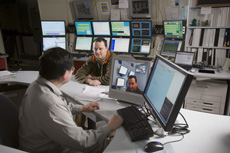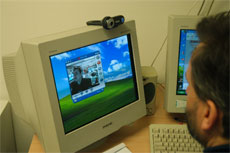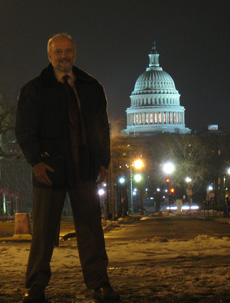|
Tue., February 27
11:00 a.m. Academic Lecture Series - 1 West
Speaker: A. Kronfeld, Fermilab
Title: Course 5, Part 2: Lattice QCD with Applications to B Physics
2:00 p.m. Research Techniques Seminar - Curia II
Speaker: H. Wieman, Lawrence Berkeley National Laboratory
Title: A High Resolution Vertex Detector for the STAR
Experiment at RICH
3:30 p.m. Director's Coffee Break - 2nd floor crossover
4:00 p.m. Accelerator Physics and Technology Seminar -
1 West
Speaker: W. Scandale, CERN
Title: Observations of Proton Reflection on Bent Crystals
at the CERN-SPS
Wed., February 28
11:00 a.m.
Fermilab ILC R&D Meeting -
1 West
Speakers: J. Norem and M. Pellin, Argonne National Laboratory
Title: Nano-Fabricated SCRF Composites
3:30 p.m.
DIRECTOR'S COFFEE BREAK -
2nd Flr X-Over
4:00 p.m.
Fermilab Colloquium -
1 West
Speaker: C. Keast, Massachusetts Institute of Technology, Lincoln Laboratory
Title: Three-Dimensional Integration Technology for Advanced
Focal Planes and Integrated Circuits
Click here for NALCAL,
a weekly calendar with links to additional information. |
Tuesday, February 28
Tomato Bisque
Lemon Pepper Club
Burgundy Beef Tips
Stuffed Manicotti
Grilled Chicken Caesar Wrap
Assorted Slice Pizza
Rio Grande Taco Salads
Wilson Hall Cafe Menu |
|
Wednesday, February 28
Lunch
-Northern Italian Lasagna
-Caesar Salad
-Cassata
Thursday, March 1
Dinner
-Seafood Soup
-Grilled Duck Breast w/Pan Asian Flavors
-Brown Rice Medley
-Vegetable of the Season
-Ginger Shortcake w/Strawberries
Chez Leon Menu
Call x4598 to make your reservation. |
|
|
Streamlining operations
successful at CDF and Pisa

Above: John Yoh and Michal Kreps share the CDF shift work with Simone Donati, who is stationed in Pisa, Italy. Below: Donati in Pisa.

You won't find any new particles in the results from the latest CDF experiment; you'll just find fewer people. The CDF main control room was once staffed at all times by four physicists, but thanks to an overnight remote operator in Europe and the combination of two local jobs into one, on some shifts the number of staffers has been reduced by half.
For one week out of each of the last four months, the 12 a.m. to 8 a.m. consumer operator "owl" shift has been carried out via internet and video conferencing by physicists at the National Institute of Nuclear Physics in Pisa, Italy, where the shift falls at a more manageable 7 a.m. to 3 p.m. Many physicists travel from abroad to serve a week-long shift at CDF's control room. Having a remote shifter "saves time and travel costs, and makes people fresher and more prepared to do their work," said Fabrizio Scuri, a physicist at CDF and at Pisa.
The consumer operator scans monitoring data distributions for errors and performs calibration checks between stores. Remote CO's are required to have served at least a one-week shift in the main control room at CDF before operating remotely. The operator in Pisa has constant contact with the main control room, but if the network connection fails, a local CO is always on call. Peter Wilson, co-head of operations with Mary Convery, hopes that all the owl shifts will be operated out of other institutions worldwide by 2008.
Convery and Wilson also directed the automation of many tasks formerly done by two researchers, called aces, who run the experiment's data acquisition and control voltage to the detectors. "Having one ace is actually easier in some ways for communications," said Convery.
The recent changes to CDF's control room are not unique; many experiments use similar tools to simplify their operations. "We have to run experiments more efficiently because so many people on CDF are also on CMS or ATLAS," said Kaori Maeshima, who develops remote operation technology for both CDF and CMS. "We have to make sure that when the LHC comes online, we don't compromise the quality of our lab."
--Christine Buckley
|
Another record
On Sunday at 8:50 p.m., the Tevatron set a new peak luminosity record. The accelerator experts on shift achieved an average initial luminosity of 292.26E30. Congratulations!
|
|

Munchies: AD's Greg Vogel snapped this picture of a coyote on Friday. He writes: "While running out to get some lunch today, I happened upon one of the local residents along Eola Road, doing much the same thing."
|
The Financial Express
February 24, 2007:
Vanishing letters of old
...Now that e-mail has replaced letter writing as the principal means of informal communication, one has to feel sorry for future science historians, who will be unable to use letters and telegrams to establish facts and gauge reactions to events.
...Catherine Westfall, who has composed histories of both the Fermilab and Argonne national laboratories, likes to point out that letters often reveal leadership styles in striking ways. "[Former Fermilab director] Robert R Wilson knew he was making history and was ironically self-conscious," she once told me. "Leon Lederman [another Fermilab director] told jokes, [while former Argonne director] Hermann Grunder wrote letters that were really never-ending to-do lists...."
Read More |
|
|
HEPAP

Fermilab Director Pier Oddone in Washington, D.C. during last week's High Energy Physics Advisory Panel meeting.
Last week I attended the HEPAP meeting in Washington, D.C. where Dr. Ray Orbach, DOE's Undersecretary for Science, talked about funding issues related to the budgets for FY07 and FY08 and about the ILC. His support of a vigorous ILC R&D program is unwavering; he sees the ILC as the next step to explore the energy frontier after the LHC. In his presentation to HEPAP, he delivered a cautionary note to our community, however: The scale and complexity of the ILC could mean a stretched-out schedule that would lead to the first ILC collisions in the mid or late 2020s. With this caution, he also requested the re-engagement of HEPAP in optimizing the opportunities for discovery from now until the 2020s.
To anyone who has studied the ILC it is no surprise that the schedule for its completion could be stretched out. The LHC will provide great discovery opportunities during this period. Realizing these opportunities is an essential step to confirming the ILC as the next global machine. It is also important during this period to have a vigorous U.S. particle physics program with great discovery potential. The P5 roadmap is such a plan, but it is based on a fast ramp-up of the ILC. In the roadmap, Fermilab will play key roles in discovery science at the energy frontier with the Tevatron, LHC, LHC upgrades and the development of the ILC; in neutrinos with MINOS and NOvA; in dark energy with DES and SNAP; and in dark matter with CDMS-25kg. If the ILC ramp-up is stretched out by several years, then it is critical to develop opportunities for discovery science along the way, especially in the accelerator-based program.
Fermilab should help HEPAP answer Dr. Orbach's request to ensure that the HEP program is robust leading up to the ILC. To do this, we must design a plan that supports the ILC as the first priority for the future and at the same time creates opportunities for accelerator-based discovery along the way. Any such plan has to start from the work done over the last couple of years by EPP2010 and the P5 subcommittee of HEPAP. It must involve the user community that Fermilab serves, as well as our many partnering institutions. It has to be a plan that fits in a global context and is adopted by HEPAP and P5 and ultimately the DOE. I am requesting a steering group composed of members of our laboratory and the community under the leadership of Deputy Director Kim to produce a detailed plan for positioning the field and Fermilab in the next two decades for a robust program of discovery based on accelerators. I am asking for such a plan by August 1st.
|
Workshop on Small-x and Diffraction
There will be a Small-x and Diffraction workshop at Fermilab from Wednesday, March 28 through Friday, March
30. New results will be presented from the Tevatron,
RHIC and HERA, together with plans and prospects for the LHC, including the
possibility of measuring properties of Higgs boson(s) through exclusive
production. There will also be talks on recent theoretical advances. During that week, a
colloquium (Wednesday at 4 pm, 1 West) will be given by Chung-I Tan on newly discovered
deep relations between gauge/string duality and diffraction. And at a Wine and
Cheese Seminar during the workshop (Friday at 4 pm, 1 West), Koji Terashi will present a variety of new
results from CDF. Registration is free, and can be done online.
Upcoming Activities |
|